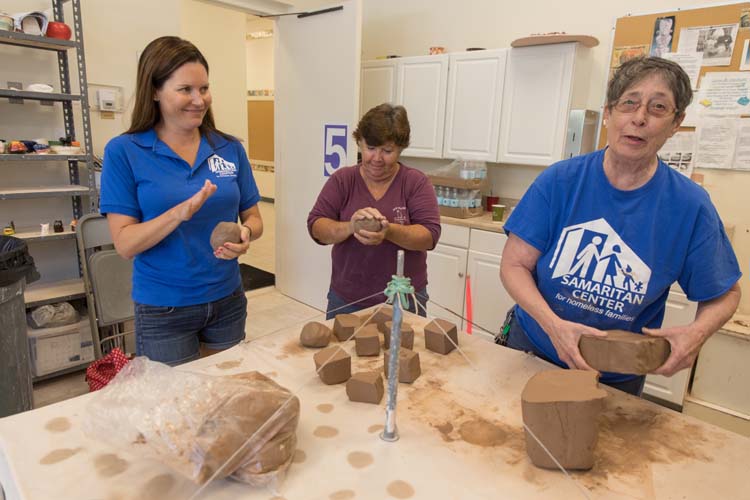
With the retirement of a large gas-fired kiln at the Vero Beach Museum of Art and a replacement not arriving until January, there was concern that the 25-year tradition of local potters making bowls to sell for a November charity event might be stymied.
But the potters for the Samaritan Center’s annual Soup Bowl event for the homeless got together with museum staff. Their imaginations “fired” up, they came up with a solution to making the 1,200 bowls in time: They simply returned to the way things were done in the beginning, firing half the bowls in the museum’s remaining kiln and the rest in their own home kilns.
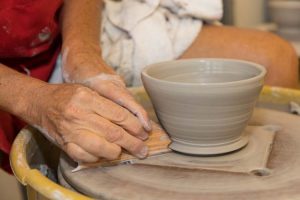
Samaritan Soup Bowl 2017
Working over a span of 100 hours last week, dozens of volunteers set up the clay, threw bowls and cleaned up the mess, firing some 600 bowls in the museum’s remaining kiln. The remaining 600 were turned out at homes and studios across the county. The result: stacks and stacks of gleaming, colorful bowls to be sold at the Soup Bowl’s 40 locations around town. At $15 a bowl, the artists’ work should contribute $18,000 to the $100,000 organizers hope to raise at the Nov. 2 event.
The museum-potter collaboration paid off in another way: For the first time, the museum will be serving soup as part of the Soup Bowl, turning over its beautiful atrium space on the day of the fundraiser. It will also display the dozen handmade soup tureens that are raffled off as part of the event.
“We’re bringing the community into the building where for so many years we’ve done the bowls,” says organizer and potter Shotsi Lajoie. The museum will become one of more than 40 Soup Bowl locations. Last year, some 5,000 people showed up for the $5 bowls of soup, specially made and donated by about 90 restaurants.
The new gas-fired kiln replacing the Ginny is a Bailey Custom Pro 32, built with greater fuel efficiency, and more importantly, code-compliant. The museum has already replaced two aging electric kilns with production-grade SKUTT kilns; those were pressed into use for the initial bisque firing of the soup bowls. An online crowd-funding page has been set up on razoo.com to raise the $9,600 by Oct. 15 to install the kilns and upgrade the electrical and venting systems in the museum.
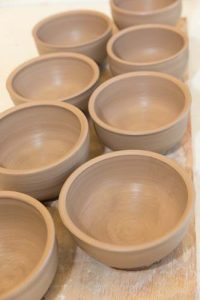
Samaritan Soup Bowl 2017
The Ginny kiln, which for nearly two decades fired the creations of the museum’s ceramics students, was custom built by Harvey Sadow, a renowned ceramicist from Palm Beach County, and Sean Clinton, the museum’s faculty manager and a well-known potter. Blazing away at 2,300 degrees Fahrenheit for up to 18 hours at a time, the Ginny was named for the late pottery instructor Ginny Stocker, who taught at the museum for 15 years.
The Ginny kiln has been instrumental in the charity event since the start, and especially as the benefit grew. With more and more bowls selling each year, it made sense for all the potters to work from the museum to maintain quality control.
“That way we use a certain type of clay and fire it to a certain temperature,” explains Lajoie. “That was easier for us.”
Having the artists come together had another benefit, one that drives a lot of people to volunteer: a sense of community interaction. “Artists are by nature reclusive,” says Lajoie, a member of the Tiger Lily co-op gallery as well as a licensed mental health counselor. “This gives them a chance to come together, to talk to like-minded people and share trade secrets. Everybody benefits from working together.”
While the town’s potters mourn the loss of good old Ginny, a giant of a kiln, the museum urged the group to use its existing smaller kilns. “We can fire about 125 bowls per load,” which is about one-third of what the Ginny kiln could fire.
The Samaritan Center provides long-term transitional housing and life skills development for homeless families in Indian River County.
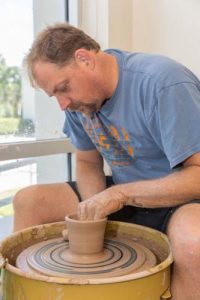
Sean Clinton.
Each November, the nonprofit hosts the much-anticipated Soup Bowl, an event that has grown over the years from soup served at a handful of local churches to about 40 locations.
The idea for the benefit came about when Lajoie and former Vero mayor Kenneth Macht were taking a pottery class at the museum. Both were board members of the Samaritan Center.
Macht and Lajoie along with their teacher Glenda Taylor made about 150 bowls that first year.
“The artists are instrumental in the success of this event,” says Renee Bireley, the Samaritan Center’s program administrator. “Where would Soup Bowl be without these potters? The bowls are truly the symbol of the homeless individual eating a humble meal of soup.”
Many of the artists have garnered an almost cult-like following. “Soup Bowl collectors run around from location to location to find bowls by certain artists,” says Clinton.
Heidi Hill’s wax resist design is an example of one of the sought-after bowls. Her butterflies and dragonflies are very popular. Glenda Taylor and Maria Sparsis are collectors’ favorites, too. “People are picking them up and looking at the bottoms to see whose they are and then other people pick the bowls by color,” adds Lajoie.
Potter Terry Green has been working in clay for 38 years, and she plans to throw 88 bowls this year – one for each year of her life. “When I have to do 100, I think it’s going to be really hard. I’ll have to start in May to get them all done in time,” says the feisty potter, who caught the mud bug when she took a class in New Haven, Conn., after all four of her children were finally in school.
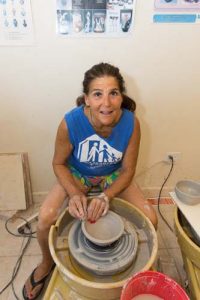
Shotsi LaJoie
And ever since then she’s been arranging her life around clay. “I do the soup bowls because I must,” she explains. “I have a heart for the homeless. The money it raises is more than I would be able to give.”
Green has thrown 62 bowls at her studio for this year’s event and will throw the other 26 during the studio sessions at the museum. “I did palm trees one year, and this year I’m doing splash designs.”
On the other end of the spectrum, there’s Linda Thiessen, a third-year Soup Bowl artist who learned of the project during a class she was taking at the Museum of Art. “The first year I threw about 12 bowls. I think last year was 24 and this year I’m going to try for 50 and they’ll have little turtles on them.”
The retired teacher was looking for a creative outlet and found more than she bargained for. “When you retire, you move and don’t know anybody, so it gave me a way to meet people that have common interests.”
A very select group of potters have been invited to produce the tureens to be raffled off. The tureens will be on display at Flametree Clay Art Gallery and Tiger Lily Art Studios before the Samaritan Center Soup Tureen Show opens in the museum atrium on Oct. 26. Raffle tickets for a chance at winning a soup tureen will be available for $1 at these locations in addition to Soup Bowl sites on Nov. 2.



